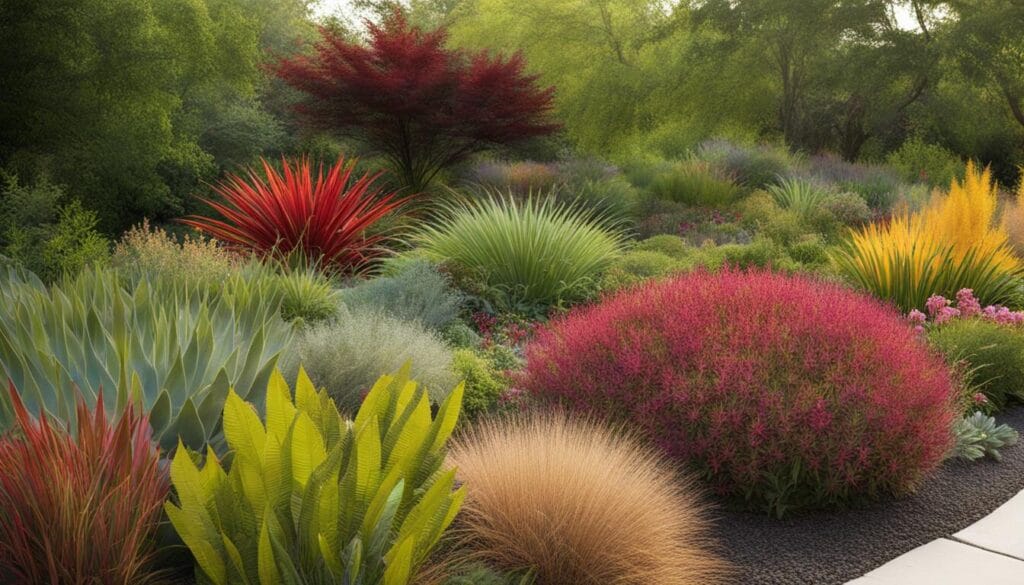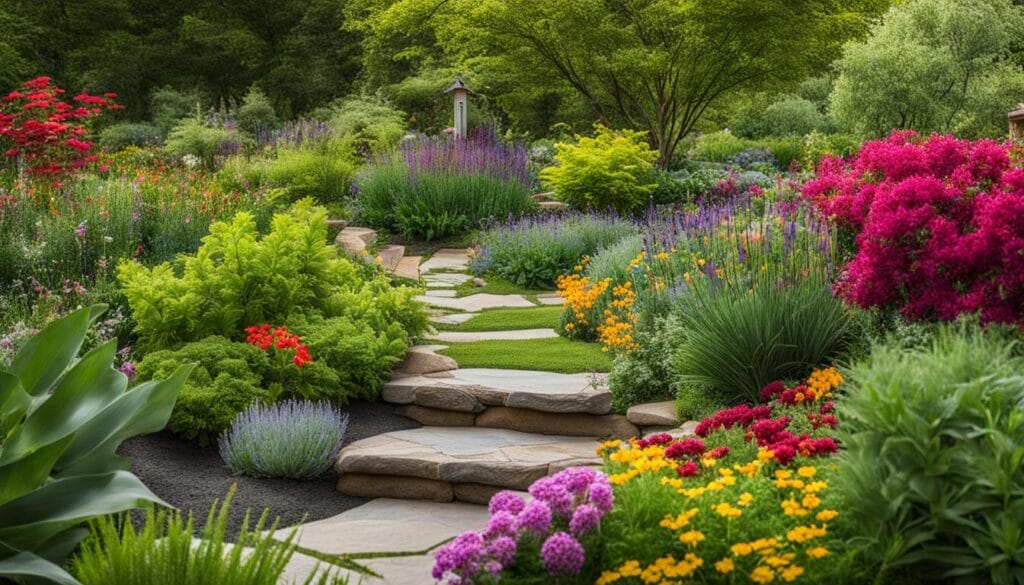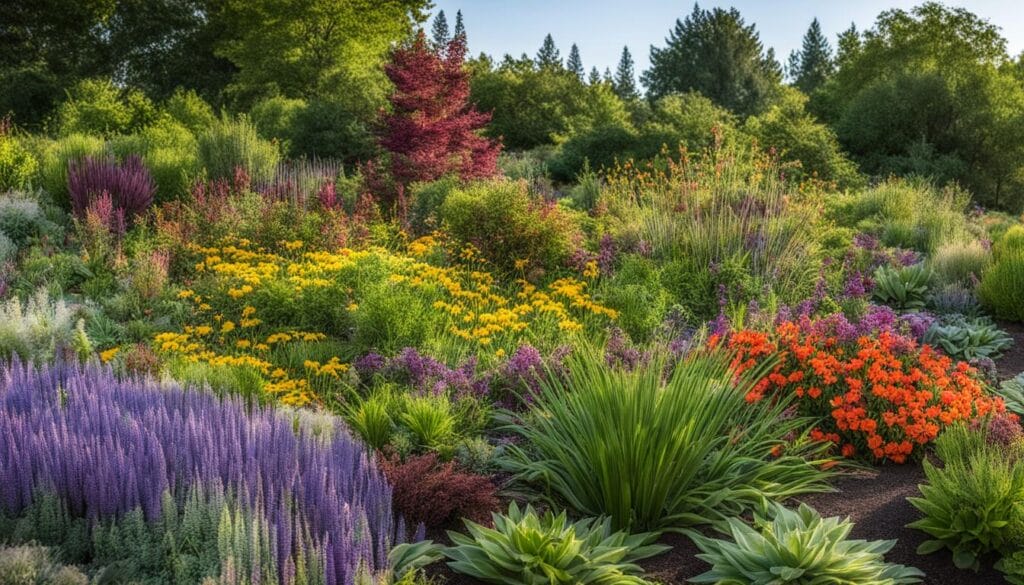Welcome to our latest article on landscape design! Today, we’ll explore the world of native plants and exotic plants, and compare their roles in creating stunning and sustainable landscapes. Whether you’re a gardening enthusiast or a professional landscape designer, understanding the differences between these two classifications is essential for creating beautiful outdoor spaces that thrive in Australia’s unique environment.
Native plants, as the name suggests, are naturally found in a specific area and have evolved to adapt to local conditions over time. On the other hand, exotic plants are introduced to an area where they are not naturally found. Both types of plants have their own advantages and considerations when it comes to landscaping.
In this article, we’ll delve into the benefits of native plants, such as their ability to attract diverse wildlife, their resilience to local climate conditions, and their cost-effectiveness. We’ll also explore the advantages of exotic plants, such as their wide variety of colors and foliage, their adaptability to local conditions with proper care, and their contribution to erosion control.
Whether you’re aiming for a sustainable landscape design or simply looking to add a touch of exotic beauty to your garden, this article will provide you with the insights you need to make informed decisions. So, let’s dive in and discover the wonderful world of native and exotic plants in landscape design!
Key Takeaways
- Native plants are well-adapted to local conditions and attract diverse wildlife, while exotic plants offer a wide variety of colors and add diversity to the landscape.
- Using native plants in landscaping promotes sustainability, reduces maintenance, improves air and water quality.
- Exotic plants, when chosen carefully, can adapt to local conditions and contribute to erosion control.
- Both native and exotic plants have their advantages and play important roles in landscape design.
- By incorporating native and non-invasive exotic plants, you can create eco-friendly and thriving gardens.
Advantages of Native Plants in Landscape Design
Using native plants in garden and landscape design provides several advantages. Native plants attract insects and birds that contribute to ecological diversity. They create habitats similar to natural environments, mimicking plant communities and attracting pollinators.
Some examples of native plants that attract birds include Westringia varieties, Coastal Pink Correa, and Callistemon. Native plants are also well-adapted to Australia’s environment, requiring less maintenance, and are resilient in the face of climate conditions.
- Native plants attract insects and birds, promoting ecological diversity.
- They create habitats similar to natural environments.
- Mimicking plant communities and attracting pollinators.
- They require less maintenance and are resilient in various climate conditions.
“Using native plants in landscape design helps to preserve the local ecosystem and supports the well-being of local wildlife.” – Landscaping Australia Magazine
Additionally, using native plants can save money compared to growing exotic plants and adds a unique Australian touch to the landscape. Incorporating native plants into your garden not only benefits the environment but also creates a visually appealing and sustainable outdoor space.
Table: Comparison of Native Plants and Exotic Plants in Landscape Design
| Advantages | Native Plants | Exotic Plants |
|---|---|---|
| Ecological Diversity | Attract insects and birds, supporting the local ecosystem | Can promote biodiversity with proper care |
| Maintenance | Require less maintenance and are resilient in various climate conditions | May require more maintenance, but non-invasive cultivars can minimize impact on the local ecosystem |
| Cost | Use of native plants can save money compared to growing exotic plants | May incur higher costs due to breeding advancements and exotic nature |
| Visual Appeal | Add a unique Australian touch to the landscape | Offer a wide variety of colors, flower types, and foliage variations |
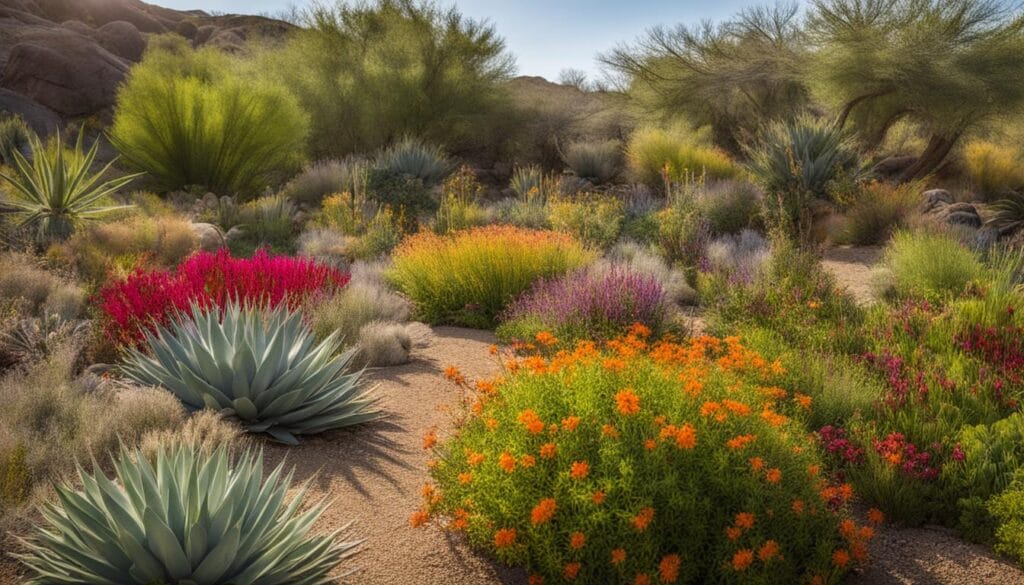
In summary, incorporating native plants into your landscape design offers numerous benefits. They attract insects and birds, create natural habitats, require less maintenance, save money, and add a unique Australian touch. Consider utilizing native plant species to create a sustainable and visually appealing garden.
Advantages of Exotic Plants in Landscape Design
Exotic plants offer a range of unique advantages when it comes to landscape design. By incorporating these plants into your outdoor spaces, you can create eye-catching displays and add a touch of diversity to your garden. Exotic plants come in a wide variety of colors, flower types, and foliage variations, allowing you to experiment with different combinations and create stunning visual effects.
When using exotic plants in landscaping, it is important to carefully select non-invasive cultivars. This ensures that the plants will not disrupt the local ecosystem or pose a threat to native species. By choosing appropriately, you can enjoy the beauty of exotic plants without compromising the balance of the environment.
Exotic plants also have the potential to thrive in Australia’s climate when provided with the right care. Recent breeding advancements have made exotic plants more resilient and adaptable to local conditions. For example, Cosmic White Rhaphiolepis and Mighty Coral Aloe are exotic plant species that can successfully withstand the challenges of the Australian environment.
| Advantages of Exotic Plants | Examples |
|---|---|
| Wide variety of colors, flower types, and foliage variations | Cosmic White Rhaphiolepis, Mighty Coral Aloe |
| Diverse and eye-catching displays | Exotic plant combinations |
| Potential to thrive in Australia’s climate with proper care | Appropriate selection of non-invasive cultivars |
By harnessing the advantages of exotic plants in landscape design, you can create visually stunning gardens that capture attention and add a unique touch to your outdoor spaces. With their wide range of colors, shapes, and sizes, exotic plants can truly transform your landscape into a vibrant and captivating oasis.
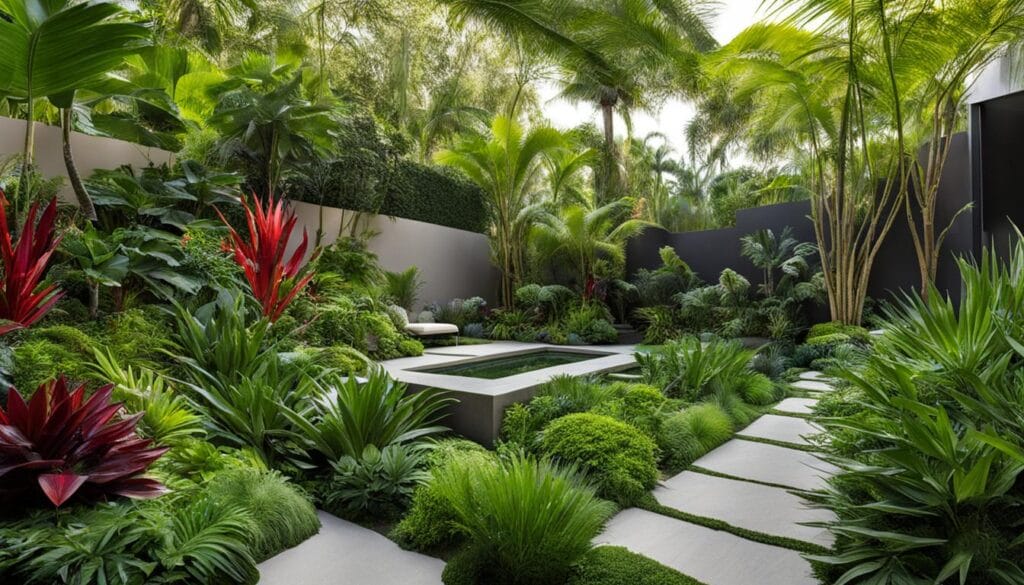
Note: The image above showcases the vibrant colors and unique foliage variations that exotic plants can bring to your landscape design.
Benefits of Native Plants in Sustainable Landscaping
Native plants play a crucial role in sustainable landscaping. Their use offers numerous benefits that contribute to creating eco-friendly and thriving gardens. Let’s explore some of the key advantages:
Reduced Maintenance
One of the primary benefits of incorporating native plants into your landscape design is the reduced maintenance they require. Native plants are naturally adapted to the local environment, making them resilient and able to thrive with minimal intervention. They are well-suited to Australia’s climate conditions, requiring less water, fertilizers, and pesticides compared to exotic plants. This not only saves you time and effort but also helps conserve resources and reduces the use of harmful chemicals in your garden.
Improved Air Quality
Another significant advantage of native plants is their ability to improve air quality. Through the process of photosynthesis, native plants absorb carbon dioxide and release oxygen into the atmosphere. This natural purification process helps remove pollutants from the air, creating a cleaner and healthier environment. By incorporating native plants into your landscaping, you can contribute to cleaner air for you and your community.
Water Quality Enhancement
Native plants also play a vital role in enhancing water quality. They have developed extensive root systems that help prevent soil erosion and promote natural filtration processes. When it rains, native plants absorb and filter rainwater, reducing runoff and the amount of pollutants entering local water bodies. This helps protect the quality of our water sources, ensuring a healthier ecosystem for aquatic life and improving the overall water quality in your area.
| Benefits of Native Plants in Sustainable Landscaping | |
|---|---|
| Reduced Maintenance | Native plants require less water, fertilizers, and pesticides, resulting in reduced maintenance requirements. |
| Improved Air Quality | Native plants absorb carbon dioxide and release oxygen, contributing to cleaner air. |
| Water Quality Enhancement | Native plants prevent soil erosion and promote natural filtration, improving water quality. |
In summary, using native plants in sustainable landscaping not only reduces the maintenance workload but also improves air quality and enhances water quality. By incorporating these plants into your garden, you contribute to the preservation of local ecosystems and create a more sustainable and beautiful outdoor space.
Importance of Exotic Plants in Landscaping
Exotic plants have a significant role to play in landscaping, offering unique benefits to enhance the beauty and functionality of outdoor spaces. By incorporating exotic plants in your landscape design, you can promote biodiversity, adapt to local conditions, control erosion, and reduce maintenance requirements.
Enhancing Biodiversity
Using a diverse range of exotic plants in your garden can promote biodiversity by attracting different species of insects, birds, and other wildlife. These plants offer unique food sources and habitats, contributing to the overall ecological balance of your outdoor space. From vibrant tropical flowers to exotic foliage, the variety of colors and textures that exotic plants offer can create a visually stunning and diverse landscape.
Adapting to Local Conditions
Exotic plants have the remarkable ability to adapt and thrive in local conditions when provided with the proper care. By selecting exotic plant species that are well-suited to your region’s climate and soil conditions, you can create a beautiful and sustainable landscape. These plants can endure harsh weather conditions, resist pests and diseases, and require minimal maintenance when established in the right environment.
Erosion Control and Reduced Maintenance
Exotic plants can play a vital role in erosion control, helping to stabilize landscape areas prone to soil erosion. Their deep root systems bind the soil together, preventing erosion and protecting your outdoor space. Additionally, many exotic plants have a natural ability to require less maintenance once established, making them an excellent choice for those seeking low-maintenance landscaping options.
| Benefits of Exotic Plants in Landscaping | Key Points |
|---|---|
| Enhancing Biodiversity | Promotes diverse wildlife, offers unique food sources and habitats |
| Adapting to Local Conditions | Thrives in regional climate and soil conditions |
| Erosion Control | Stabilizes landscape areas prone to soil erosion |
| Reduced Maintenance | Requires less upkeep once established |
Incorporating exotic plants alongside native species can create a harmonious balance in your landscape design, offering both aesthetic appeal and environmental benefits. However, it is crucial to choose non-invasive exotic plant cultivars to prevent any disruption to the local ecosystem. By carefully selecting and maintaining exotic plants in your garden, you can enjoy their unique attributes while ensuring the long-term sustainability of your landscape.
Conclusion
In conclusion, both native plants and exotic plants have their own advantages and contribute to sustainable landscaping in Australia. Native plants play a crucial role in supporting local biodiversity, conserving resources, and requiring less maintenance. They are well-adapted to Australia’s environment and attract insects and birds that contribute to ecological diversity. By incorporating native plants into your garden, you can create an eco-friendly space that thrives with minimal effort.
Exotic plants, on the other hand, can add aesthetic benefits to your landscape and adapt to local conditions with proper care. It is important, however, to select non-invasive exotic plants to minimize the impact on the local ecosystem. With careful consideration, exotic plants can provide diversity and visual appeal to your garden.
As we strive for sustainable landscaping practices, incorporating both native and non-invasive exotic plants can create a balanced and thriving garden. By choosing the right plants for your landscape design, you can create an environment that supports local wildlife, conserves resources, and adds beauty to your surroundings. So, embrace the benefits of native plants and carefully selected exotic plants to create a sustainable and flourishing garden that you can enjoy for years to come.
FAQ
What are native plants?
Native plants are plants that grow naturally in a particular area without human intervention and are well-adapted to the local conditions.
What are exotic plants?
Exotic plants are plants that are introduced into an area where they are not naturally found.
What are the advantages of using native plants in landscape design?
Using native plants attracts insects and birds, creates natural habitats, requires less maintenance, saves money, and adds a unique Australian touch to the landscape.
Can exotic plants thrive in Australia?
Exotic plants can thrive in Australia with proper care and selection of non-invasive cultivars.
What role do native plants play in sustainable landscaping?
Native plants promote biodiversity, conserve resources, require less maintenance, improve air quality, and enhance water quality.
What is the importance of exotic plants in landscaping?
Exotic plants can promote biodiversity, adapt to local conditions, contribute to erosion control, and provide aesthetic diversity.

